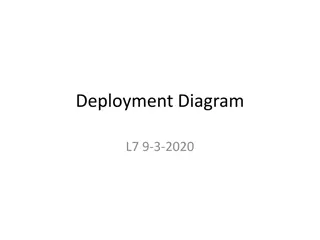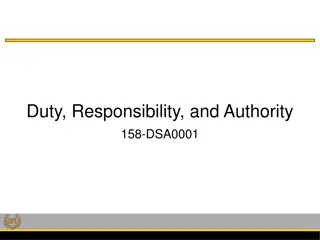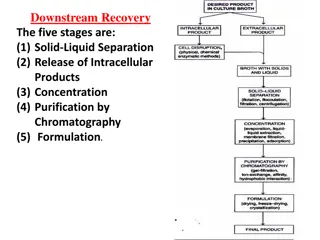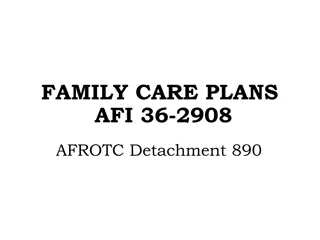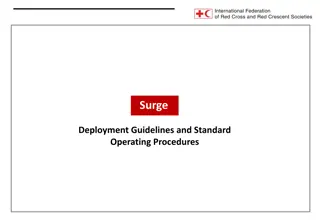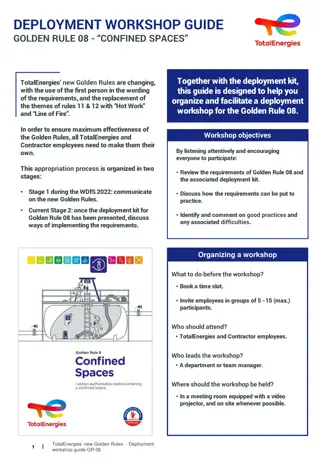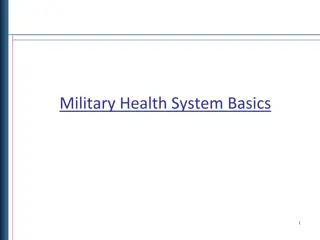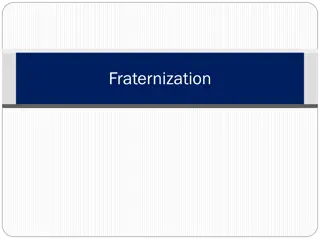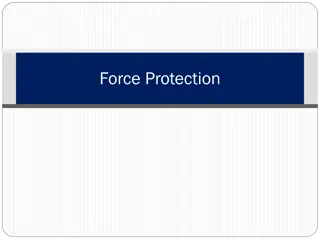Understanding Deployment and Separation Data in Military Healthcare
This information delves into the deployment and separation data related to military service members, focusing on how data changes during deployments and the importance of considering deployment in rate calculations. It also covers the objectives, ownership, and restrictions on the use of this data by the Defense Manpower Data Center (DMDC) and the Defense Health Agency (DHA). Additionally, the content explores the impact of deployment on medical and dental readiness in the context of the ongoing war scenarios in the US.
Download Presentation

Please find below an Image/Link to download the presentation.
The content on the website is provided AS IS for your information and personal use only. It may not be sold, licensed, or shared on other websites without obtaining consent from the author. Download presentation by click this link. If you encounter any issues during the download, it is possible that the publisher has removed the file from their server.
E N D
Presentation Transcript
Deployment and Separation Data
Objectives Deployment related objectives: Describe how data changes when Service members are deployed. Discuss importance of considering deployment when calculating rates, and especially when comparing rates amongst the Services. Describe the deployment data Separation related objectives: Describe the Separation data. Discuss the values of the separation codes.
Objectives Both Deployment and Separation data are owned by the Defense Manpower Data Center (DMDC) DHA has Special Project Agreements with DMDC that enable the use of these data under certain circumstances. Internal users can utilize flag variables that have been appended to all of the data types from the deployment data. DHA cannot release CTS or Separation data externally unless the recipient has a signed Special Project Agreement with DMDC
Deployments The US has been at war for the last 17 years This has placed incredible stress on the MHS. The MHS is responsible for ensuring medical and dental readiness for all Service members. Ensuring readiness for active duty is an ongoing function of the MHS. Since Guard/Reserve have sporadic coverage with DoD, there is a 30 day early alert period where the MHS can provide the healthcare services needed to get the Guard/Reserve ready to deploy. Providers also deploy from MTFs, and often those providers care for more than just the Active Duty that deployed with them, leaving a gap that requires backfills, etc. Obviously, the deployment file can be used to build a list of deployers.
Deployments Includes data from 9/11/2001+ Contents of the Deployment Data DEERS Person ID & Social Security Number Deployment Start and Stop Date Death Date Gender, Date of Birth, Zip Code, Service Branch The deployment file contains buffer records which span the gaps between deployments. This was a system requirement so that the MDR s data mart could apply deployment data properly. These should be removed by limited to record type = D , for deployment record.
Deployments Excludes Coast Guard due to small numbers
Deployments When Service members deploy, DEERS does not change their address to represent where they deploy to; Service members remain listed at their home base. This can greatly impact measurement of things like utilization rates because the member will show up in the denominator but have little opportunity to appear in the numerator. Incorporating TMDS data into work can be helpful. However, TMDS data is known to be incomplete and is not coded as well as regular peacetime healthcare data. Many analysts use deployment data to adjust
Deployments Example of impact of deployment on rates What is the emergency department utilization rate for active duty service members who live near Fort Polk each month in 2018? Direct Care ER Visits + Purchased Care ER Visits *100 Number of DEERS Eligible Beneficiaries
Deployments Includes Deployed Members Does Not Includes Deployed Members
Separations DHA started to receive separation data from DMDC in 2002/2003 to support the Federal Health Information Exchange (FHIE) project. For this project, DHA used the separation list to filter out healthcare records to send to the VA to use for disability evaluations. The data was otherwise restricted. Two years ago, DMDC and DHA expanded the terms of the SPA that covered this work to include some other limited projects.
Separations Records are included in the Separation file when A Service Member retires A Service Members discontinues Service ( gets out ) A Service Member switches Pay Plan (goes from enlisted to officer, etc) Includes Active Component and Guard/Reserve. Does not include records when Guard/Reserve go off of active duty orders, only when they separate
Separatee File Includes data back from FY 2002 Contents of the Separatee file include: Service Component (Guard, Regular, or Reserve) Separation Date Reason for separating (death, retirement, disciplinary issues, etc) Pay Grade Data also includes standard patient identifiers: Date of Birth SSN EDI-PN
Separatee File Frequency of Separations by Service this year (excludes separations due to pay plan change) Month October November December January February March April May June July Army Coast Guard Air Force 25,215 Marines 26,664 Navy 6,713 6,449 6,419 5,257 5,544 6,318 5,914 6,973 6,648 6,403 62,638 218 222 137 212 156 227 236 326 433 285 2,550 2,556 2,500 2,478 2,344 2,351 2,264 2,587 2,768 2,817 2,605 1,911 2,233 2,371 1,832 2,235 1,974 1,969 6,252 3,282 2,972 2,665 2,788 2,829 2,811 3,391 3,404 3,409 3,177 3,490 30,936 2,452
Separatee File There are often spikes in separations from the Service, especially around the end or beginning of a fiscal year.
Separatee File Separation codes define the reason for separation. FY2018 Separation Reason Expiration of term of service Retirement, 20 to 30 years of service Unqualified for active duty, other Permanent disability retirement Disability, severance pay Temporary disability retirement Entry level performance and conduct (former Trainee Discharge program) Officer commissioning program Drugs Commission of a serious offense Count 59,376 16,528 12,429 6,324 5,942 5,827 5,617 5,169 4,890 3,493
Separatee File Disability Separations FY2018 Type of Disability Permanent disability retirement Disability, severance pay Temporary disability retirement Disability, no condition existing prior to service, no severance pay Total Army Coast Guard Air Force Marines Navy 12,928 4,914 4,231 3,768 98 7 40 836 559 517 219 636 563 36 257 509 939 15 3 145 1,912 1,454 1,708




